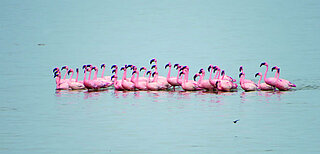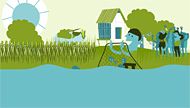Cross-sectoral bird protection

Climate change mitigation and conservation of biodiversity can only succeed with a holistic approach—interview with project manager Marijin van Leeuwen.
Migratory birds cross several continents on their journeys. Wetlands are an important resting and breeding place for them. Climate change mitigation and the conservation of biodiversity are essential for the protection of migratory birds. This is why climate and biodiversity aspects must be taken into account with local stakeholders using a cross-sectoral approach. Merijn van Leuwen, project manager with Wetlands International, explains in this interview how the holistic approach of the project “Climate-resilient site network in the African-Eurasian flyway” is implemented locally.
What makes your IKI project for the protection of migratory birds stand out?
Merijn van Leeuwen: We link the debate on biodiversity with the adaptation to the impacts of climate change. And we show how it works. Our work is mainly landscape-based, i.e., we involve all affected groups and focus on changes in the availability of water. The availability of water represents the decisive challenge for nature and people. Wetlands are ecosystems that offer a whole range of significant “benefits”, for example, by regulating the water balance or as carbon sinks. We observe all the consequences for migrating waterfowl. Typically, these breed in the high Arctic and spend the winter in tropical Africa. Therefore, it is not enough to consider just one aspect. We need to know what’s happening in all the wetlands along their flight route.
How does your project contribute to climate change mitigation?
We work on four levels: In the field of flight paths, a consortium of universities will soon publish a study showing the consequences of climate change on rivers and lakes. We will also investigate the quality of wetlands in Europe, Africa, and the Middle East. Locally, we do not work “in silos”, but collaborate across different sectors with local stakeholders. Our partners include the public institutions responsible for forests and valleys as well as farmers and businesses. The business world also has a clear interest in the topic. Lake Abijatta, for example, is home to 250,000 flamingos and ducks and is the most important waterbird biotope in Ethiopia. The main threat to the lake is high water consumption. Having enough water is of utmost importance for birds, the people, and the regional economy. Ecosystems offer great ecological, social, and economic value. At the national level, we are working in Mali and Ethiopia to ensure that the protection of wetlands and nature is integrated into the local climate change mitigation agenda. We achieve this in cooperation with the relevant ministries, but also with internationally recognised NGOs and think tanks. We are also approaching other countries in Africa and the Middle East to promote the integration of biodiversity and climate change mitigation throughout the region.
How does this fit in with the IKI?
The IKI aims at conserving biodiversity and mitigating climate change, closely linking these two objectives. This is precisely what we do in our project.
How does the cooperation between national and IKI staff work?
We have project offices in Mali and Ethiopia, where the work plans are drawn up, and most of the local measures are implemented. Our staff from the Netherlands also supports the project office in the target countries. But it is mainly our country-specific teams, local departments, government agencies, and NGOs that do the work. I meet with them in steering committees, but they do the strategic work. It is necessary to be present in the partner countries. Only local people can make a real difference. Thirty percent of the changes we want to bring about depend on information and data. The rest is to show that something can be done. We need to build a relationship with those who will have to live with the changes or make decisions about them afterwards - and empower them to do so.
What are your personal wishes for biodiversity projects like yours in an international context?
It is crucial to combine the adaptation to the impacts of climate change and the mitigation of greenhouse gas emissions with the discussion on biodiversity. And this link should be maintained. And it is imperative to use this integrated approach to tackle the increasing threats to people and nature resulting from water shortage and the degradation of soils.
What else would you like to say to the readers of our report about the practice of climate change mitigation and the related challenges and prospects?
Climate change and the overuse of natural resources make it very difficult to provide sufficient food in Africa and South Asia. This has a massive impact on the availability of water. How can we combine these two goals while conserving biodiversity and the related ecosystem services to humanity? This is the biggest challenge.
The link has been copied to the clipboard
Contact
IKI Office
Zukunft – Umwelt – Gesellschaft (ZUG) gGmbH
Stresemannstraße 69-71
10963 Berlin







